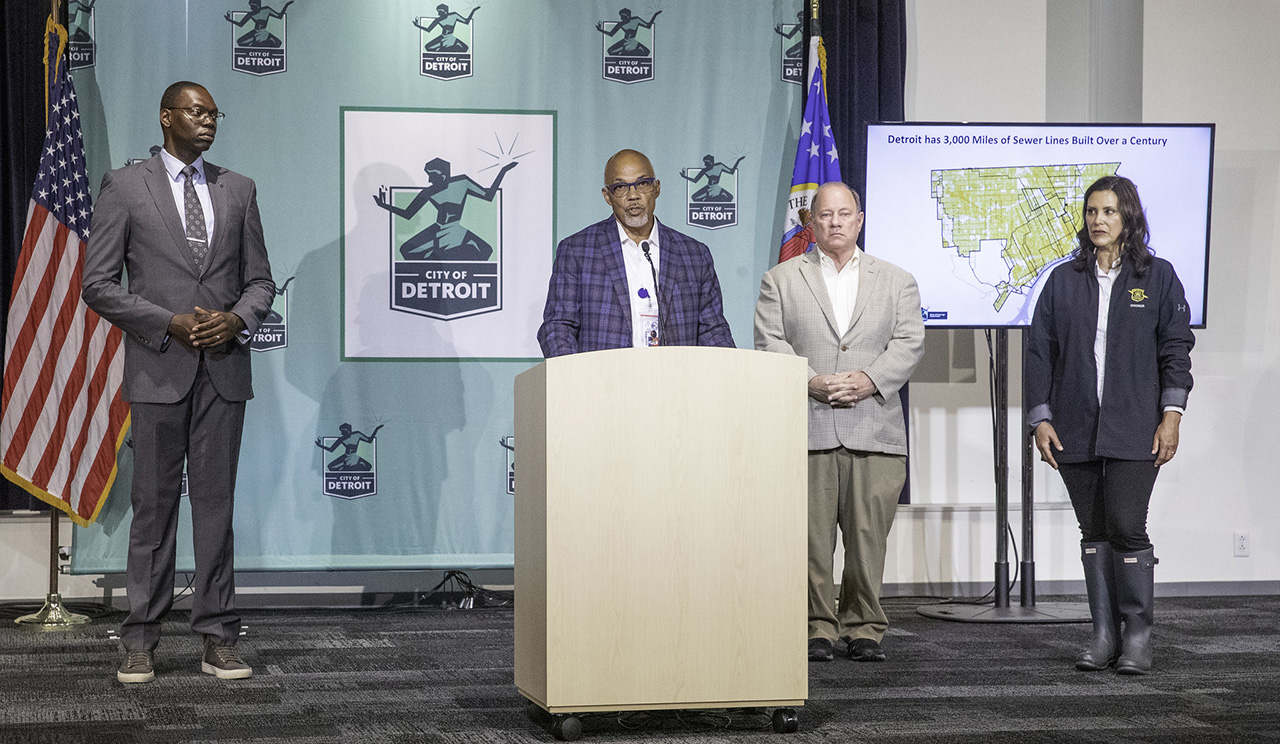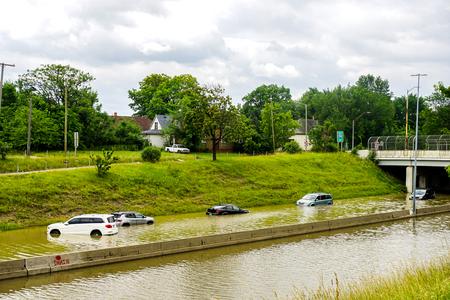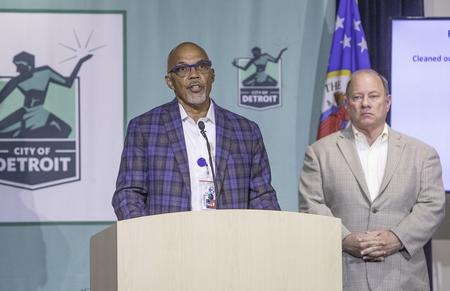Detroit Seeking Help From FEMA After Historic Rain Event, Investing Millions in Infrastructure
The Detroit Water and Sewerage Department is putting $75 million toward water and sewerage improvements and the Great Lakes Water Authority has pledged $750 million to improve drainage and pumping systems.

Detroit is still assessing the damage caused by last weekend’s flooding, and officials are asking the Biden administration for a presidential disaster declaration.
“We have to make a formal request with a lot of documentation,” said Mayor Mike Duggan. “I’ve been talking to the White House, and the governor has been talking nonstop. They know this is coming in. They know that we need help.”
“We have never seen this kind of rain volume in our area in this short period of time.” –Mayor Mike Duggan, on the nearly 6 inches of rainfall recorded on Friday
The request for support from the Federal Emergency Management Agency is not the first time southeast Michigan sought relief from a water emergency. FEMA previously responded to flooding in southeast Michigan in 2014, and the agency approved more than $170 million in public and individual assistance.
“In August 2014, we set a record: 4.57 inches in one day,” said Duggan, adding that the city recorded 5.77 inches on Friday, twice as much rainfall than the entire monthly average for June.
“Not only is this record, this beat the old record by a huge amount. This was not your imagination. We have never seen this kind of rain volume in our area in this short period of time.”
Detroit does not have a final tally on the damage, but city officials have already received thousands of requests and responded to emergency hazards in homes. The Detroit Public Works department is continuously picking up bulk debris from curbs in affected neighborhoods, and the city is organizing a list of volunteers to help with the cleanup.
City officials have identified 10 areas in Detroit with severe basement flooding, with the Jefferson Chalmers neighborhood and Aviation Subdivision particularly hard hit. Detroiters have a 45-day window to file a claim.

Gov. Gretchen Whitmer declared a State of Emergency at the onset of Friday’s downpour when flooding took over various freeways in Metro Detroit.
“I visited the Garden City hospital to meet with first responders and frontline medical workers, and I also popped in over at Dearborn Heights and met with the mayor and Congresswoman [Rashida] Tlaib,” said Whitmer, who was in Detroit Monday touring the damage. “At the state level, we have moved quickly to make sure that we are in a position to get assistance into our state and to help so many families and businesses that have been impacted by the flooding.”
Citing last year’s flooding in Midland and other infrastructure failures in the state, Whitmer calls for legislation to address aging pipes and drainage systems.
“The Michigan Clean Water Plan, which I put forward months ago, proposes a $238 million investment in stormwater upgrades that would help tackle challenges that we are seeing right now,” said Whitmer. “And in my executive budget, I recommended $40 million for climate-resilient infrastructure.”
State officials say the need for an infrastructure plan is crucial amid a changing climate, where more extreme weather events are predicted to occur.

“Every day that we don’t take direct action in response to the challenges that climate change presents us with will cost us,” said Lt. Gov. Garlin Gilchrist. “Every day we don’t take action, we are losing more and more in this race against climate change. And these events will continue to wreak havoc on our communities, and most importantly, on our people across our state.”
The Detroit Water and Sewerage Department points to excessive rainfall for water damage that has seen basements ruined and vehicles scattered along flooded roadways.
“When you get five inches in five hours, and you have two inches a few hours before that, the system just can’t maintain it,” said DWSD Director Gary Brown. “The pipes are going to fill up, and they’re going to surcharge into basements. There’s nowhere for the water to go.”
Over the last three years, Brown says DWSD cleaned out 30,000 catch basins, cleared 575 miles of sewers, and rehabilitated another 50 miles of sewers. The utility is putting $75 million toward water and sewerage improvements and the Great Lakes Water Authority has pledged $750 million to improve drainage and pumping systems.
“Results showed last weekend, the record rainfall receded from streets and basements far more quickly than in 2014,” said Brown. “Much more is needed.”
Listen: Detroit Water and Sewage Department Director Gary Brown on the lessons learned from this historic rain event.
WDET’s Eli Newman spoke with DWSD Director Gary Brown about the flooding. Read excerpts, edited for clarity, below:
Newman: What do these future infrastructure investments buy the city? Does it get us where we need to be?

Brown: Detroit – DWSD – was going to put about $75 million into the system, specifically the pipes that are in the system. The $750 million [from GLWA] a great majority of it will go into the plants, the wastewater treatment plants, the pumping stations, the combined sewer overflow facilities and will also help rebuild the transmission lines that feed the city of Detroit, but also feed 60% of the state of Michigan because the Great Lakes supplies even water sewer to 60% of the state.
Sure. So $75 million for DWSD?
Just for the distribution center, the smaller pipes that are in the city of Detroit. And then, the Great Lakes Water Authority is responding to the transmission lines that feed the distribution system.
Distribution meaning water to people?
Yes, water that are pipes that run through the city that hook to homes or businesses.
Obviously, there’s the whole lead mitigation effort …
That’s a part of it. We’ve got a big program.
What do you think of people who say since 2014, it seems like we’re in the same boat now that we were a couple of years ago?
Yeah, I know that it may seem, but let’s take 2016 when we had the storm in Jefferson Chalmers. It took us three weeks to dry up the streets and pump out water out of people’s homes. We got that done in almost two hours with this particular storm, and that’s because we’ve gone in and cleaned the sewer lines, relined the ones that were weak, and replaced the ones that needed replacing, and built more capacity. But again, when you get five inches of rain in five hours, and you had two inches a few hours before that, the system just can’t maintain it. It’s going to fill up, the pipes are going to fill up, and they’re going to surcharge into basements. There’s nowhere for the water to go.
I know the people are still making claims and still coming in, but do we even have a sense of the damage and how much?
Yeah, so we do know where the hardest-hit areas are. After two days, I don’t have a good handle on a number of homes, but it’s going to be significant.
“We control a lot of the land, and we have the opportunity to be the greenest city in America.” –Gary Brown, Detroit Water and Sewerage Department
I guess I’m just wondering, are there any lessons to be learned about where we are now?
Every opportunity that you have to separate stormwater from sewer, the combined system — we created an ordinance that requires businesses like Fiat Chrysler to manage the 100-year storm on site. We have to take every opportunity. Detroit is unique. We control a lot of the land, and we have the opportunity to be the greenest city in America. Every opportunity we can take to take water out of the system by dealing with it more naturally in a green infrastructure way is, is the lesson that I take from that.
Is there any evidence to suggest that what happened at FCA with their retention pools? Is there any sense of their failure or anything there?
No, there was no failure. They just got overwhelmed. They were built for the 100-year storm, and we had the 500-year storm.
Sure, but we’re talking about a fairly new industry in the city that’s taking place during this climate change moment.
That plant has been here for 40 years. They added on to the plant, and when they added the new plant and put in impervious surface, then they were required to manage the stormwater coming off of that. And they did, by building the retention ponds. Unfortunately, it was more water than the detention ponds were designed to manage.
So even what our current standards are then might not be enough to address the water that’s coming our way?
Not if you get a 500-year storm. What that really means is there’s a half a percent chance every year that you can get that.
Trusted, accurate, up-to-date
WDET is here to keep you informed on essential information, news and resources related to COVID-19.
This is a stressful, insecure time for many. So it’s more important than ever for you, our listeners and readers, who are able to donate to keep supporting WDET’s mission. Please make a gift today.
